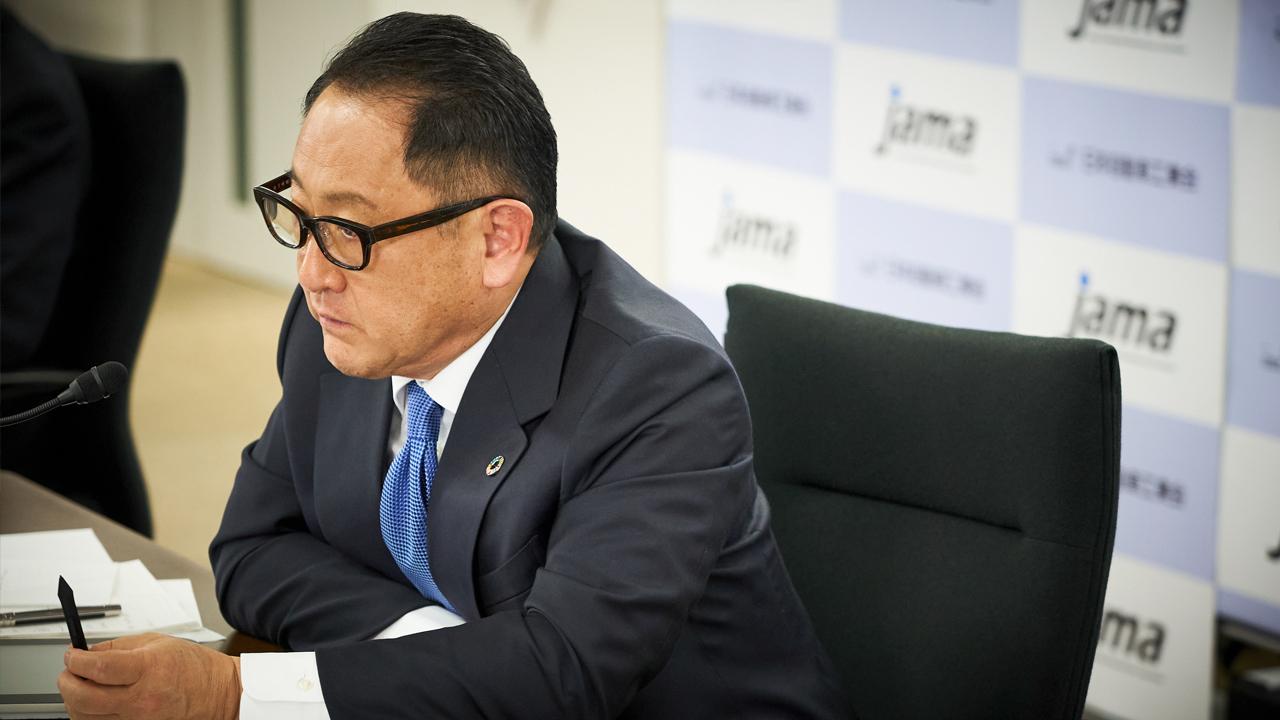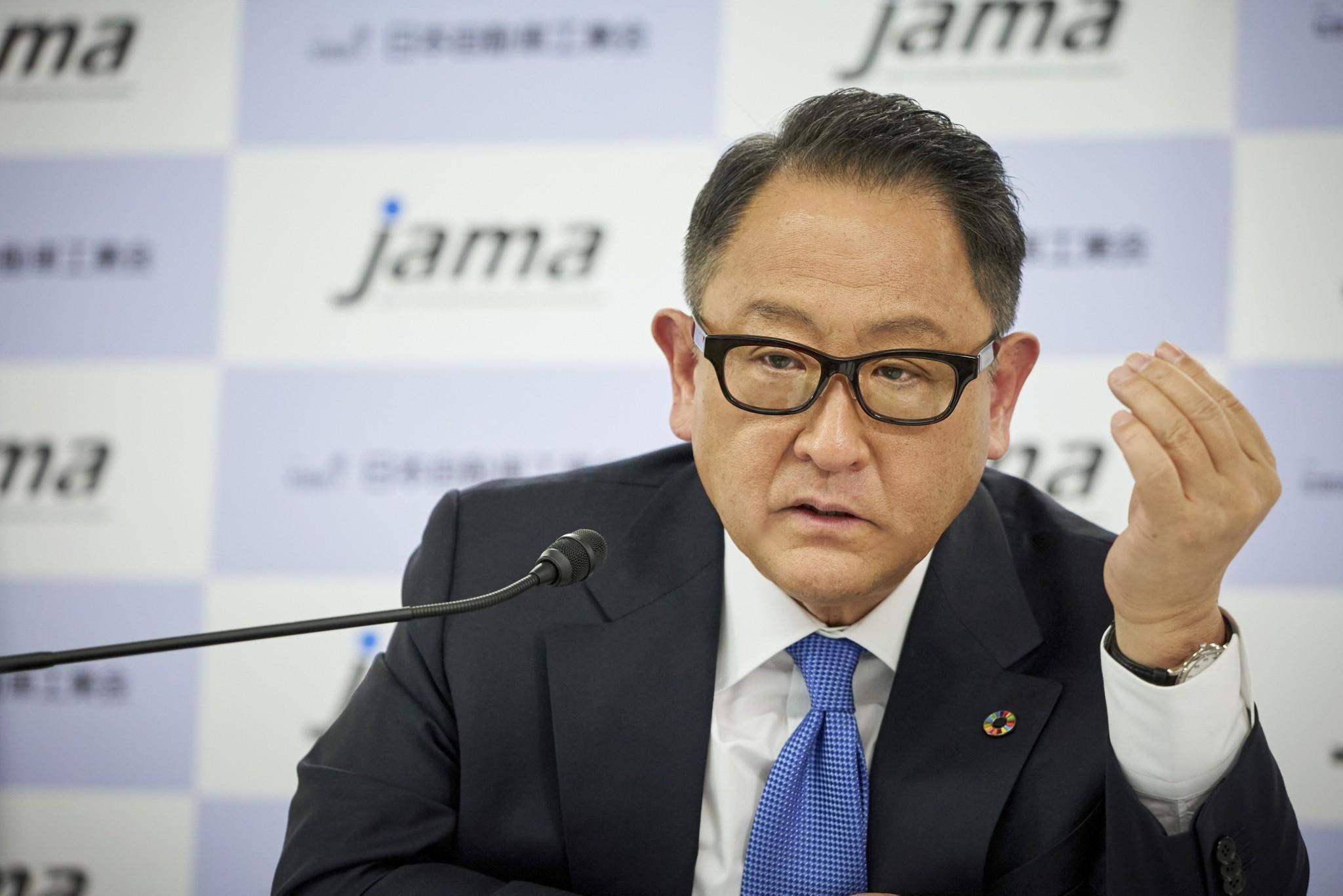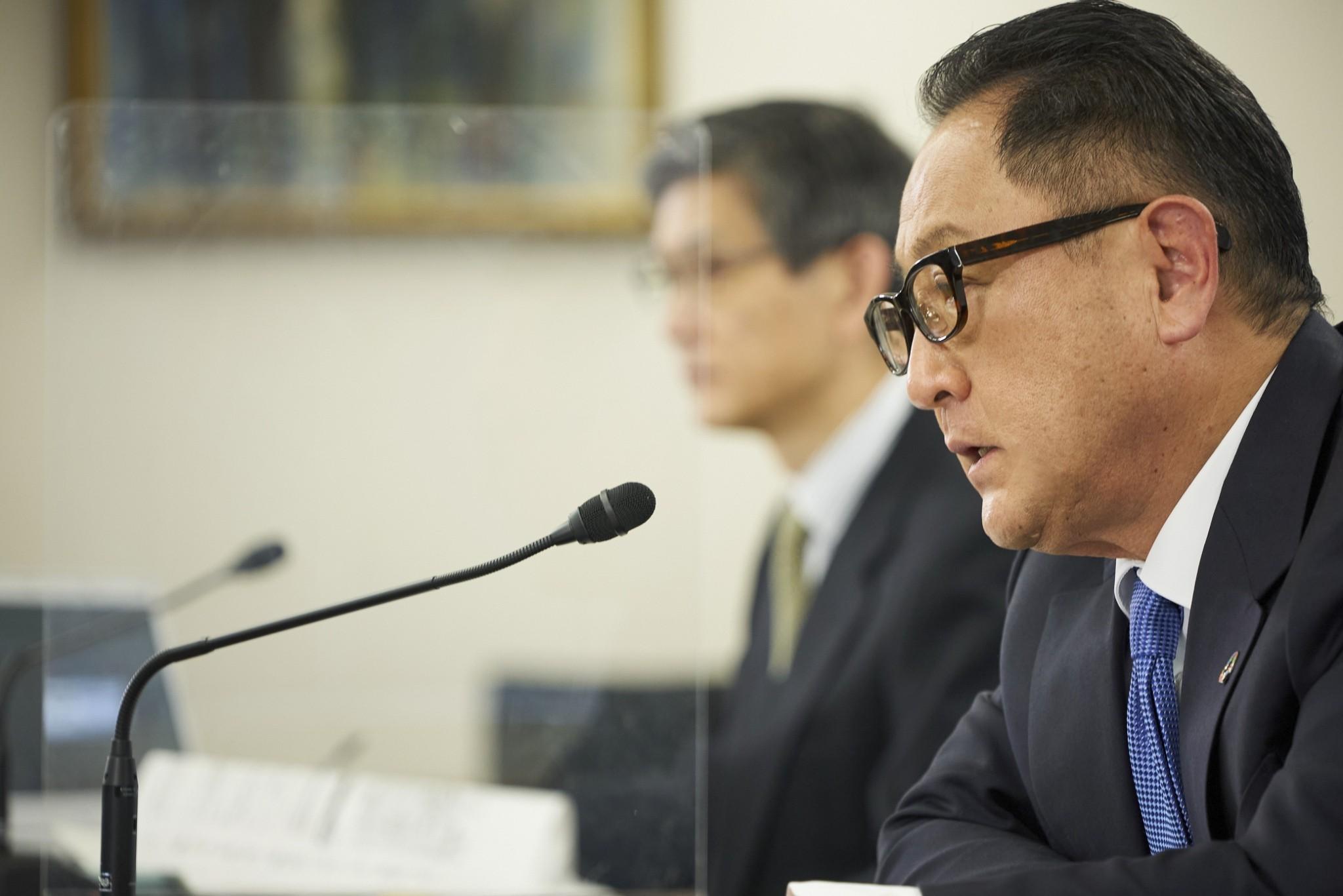
At a press briefing on April 22, JAMA Chairman Akio Toyoda repeatedly stressed that "our goal is to be carbon neutral, and there should be more than one path to that goal." Find out what he meant by the key message.

World leaders attended a virtual summit on climate change on April 22.
At the summit, Japan announced that it would aim to slash greenhouse gases by 46 percent compared to 2013 by 2030 and “continue trying for an even higher cut of 50 percent”. That translates into a greater-than-70 percent leap from Japan’s previous target.
On the morning of the day that the target was announced, Akio Toyoda, as chairman of the Japan Automobile Manufacturers Association (JAMA), faced the media at an online press briefing. His message at the briefing centered on how Japan should find its own path to carbon neutrality while being aware of its own strength.
At a JAMA press briefing on March 11, Akio expressed a sense of crisis when he commented that achieving carbon neutrality was also a “fight to protect Japanese manufacturing”. But what was his vision this time?
The path to carbon neutrality lies in Japan’s strengths
JAMA Chairman Akio Toyoda
Today, I would like to continue my discussions on carbon neutrality, which is an urgent and important topic for everyone in Japan and every industry.

Looking back to December last year, I explained that JAMA would do its utmost to help achieve carbon neutrality, but that such has to be done in tandem with energy policies.
Last month, I shared my sense of crisis on how pursuing carbon neutrality could lead to a shift of production to countries and regions that can procure clean energy, which could, in the end, result in losing automobile exports from Japan and employment in Japan.
In all of these cases, the underlying principle is that we all need to correctly understand the essence of carbon neutrality and respond to it with everyone’s involvement.
As I continue to work on "correct understanding", I have started to think that there is a unique path for Japan to achieve carbon neutrality.
Akio’s message as JAMA chairman has hitherto been one of responsibility, with the automobile industry being a core industry in Japan, and of the spirit of love for Japan. But, this time, he talked about a unique path for Japan to achieve carbon neutrality. Let’s zoom in on his comments.
Japan has many excellent environmental and energy-saving technologies. Above all, I believe that Japan's unique strength lies in its "composite technology" that combines superior individual technologies.
The energy industry is now working on the technological innovation of carbon-neutral fuels such as e-fuels made from hydrogen, and biofuels.
When this new type of fuel is combined with the high-efficiency engine and electric motor technologies accumulated in the Japanese automotive industry, I believe we will see a whole new world where we can significantly reduce CO2 emissions.
If this is to be realized, not only will existing infrastructure be usable, but all vehicles including used vehicles and vehicles already on the market will be able to reduce their CO2 emissions.
And this concept can be applied to a variety of industries other than autos, such as ships and airplanes.
If carbon neutrality of transportation, especially of ships, gets advanced, it will lead to making greener Japan's business model, which is largely driven by imports and exports.
Until now, discussions on types of electrified vehicles, such as battery electric vehicles (BEVs) and hybrid electric vehicles (HEVs) had mostly taken center stage. However, combining such a focus with the idea of “fuel that offsets CO2 emissions in its production and use cycle” provides a broader perspective on how to reduce CO2 emissions.
For example, when a certain amount of e-fuel is mixed with gasoline, it can reduce the CO2 emissions of gasoline-powered vehicles to the level of those of HEVs. Using it in HEVs can reduce CO2 emissions to the level of those of plug-in hybrid vehicles (PHEVs). And using it in PHEVs can reduce CO2 emissions to nearly zero, almost the same level as BEVs. Combining carbon-neutral fuel with the engine technology that the Japanese automobile industry has refined creates new possibilities.
This can lead to CO2 reductions not only in automobiles but also in all fields, such as marine transport and others. And, with Japan being an island country scarce in natural resources, it would represent the kind of technological innovation that is needed for Japan’s business model.
Japan lacks natural resources, but through its technology can it overcome such a disadvantage.
It’s not only about addressing new cars
Simply addressing new cars is not enough for achieving carbon neutrality.
Japan has 78 million cars on the road. Compared to new cars, the electrification rate among them is low. It will be difficult to achieve carbon neutrality as a nation unless there are steps to address vehicles already being owned.
Also, people are holding on to their cars longer in Japan. Taking these points into consideration, even if all cars in Japan’s annual new-car market of 5 million units were to be zero-emission vehicles, it would still take more than 15 years to replace all current units in operation.
And, realistically speaking, not all new cars will be replaced that way, so if it is assumed that at least half of them are, it will take more than 30 years to replace all of them when currently owned cars are added to the equation.
Discussions hitherto only focused on new cars to come. But in thinking in terms of the path to the goal of carbon neutrality, one must not overlook the CO2 emissions of cars already owned and currently in use. That is why Akio stressed the need to think about technological innovation in fuel.
In short, Akio proposed to consider combining the technologies that Japan has cultivated for improving engine fuel efficiency and its technologies related to carbon-neutral fuel as an option for making use of Japan's strengths.
The significance of making the automotive industry a pacemaker
Against such a backdrop, Akio went on to talk about the need for a “pacemaker” in moving all toward the goal of carbon neutrality.
Our goal is to be carbon neutral, and there should be more than one path to that goal.
We have carbon-neutral fuel technologies, engine combustion technologies, electrification technologies such as electric motors and batteries, and composite technologies that combine these technologies -- I believe that there is a path for Japan to choose in which we can fully take advantage of our strengths.
Carbon neutrality cannot be achieved without reducing CO2 emissions throughout the entire process: making, transporting, using, and disposing of.
In other words, it is essential for all people and all industries to align and work together. And that is where we believe we need a "pacemaker".
Since the automotive industry is a comprehensive industry that deeply engages in many industries such as energy and materials, we believe that we can play a key role as a pacemaker for industry overall.
There is more than one path to carbon neutrality. Akio’s expression when talking about such was resolute, and he explained more about the significance of the automotive industry serving as a pacemaker.
And another reason for wanting to be a pacemaker is because we are a B2C (business-to-consumer) industry with many points of contact with customers.
As a result of our efforts to meet the needs of our customers, the Japanese automotive industry has the advantage of having a full lineup of electrified vehicles.
No matter how advanced the technology is, it would be meaningless if it is not chosen and used by customers. We believe that we can play a role as a pacemaker in changing our customers' lifestyles toward being more carbon-neutral.
When I say that we want the policymakers to let the automotive industry play a central role in pursuing carbon neutrality, it is not because we want to protect our industry by doing so.
Rather, it is because we want to play an important role for our home country Japan to achieve carbon neutrality through serving as a pacemaker.
The order must be right
At this point in the press briefing, Akio made known a JAMA request to the government. It was perhaps no coincidence that the briefing was held on the day of the climate change summit of world leaders.
At the recent U.S.-Japan Summit, Prime Minister Suga expressed his strong will to accelerate efforts toward carbon neutrality by setting a milestone of 2030.
What Japan should do now is to widen the options of technologies. Regulation and legislation should come after that.
A policy that bans gasoline and diesel vehicles from the outset will only make the options narrower and may even end up losing its strength. I request that the Japanese government not let this order be reversed in the policy-making process.

In the quest for carbon neutrality, this illustrates how Japan will survive. Narrowing the options will only constrain the technological capabilities that Japan has painstakingly cultivated, possibly leading to the weakening of Japan as a country.
In the following Q&A session with reporters, Akio was asked whether Japan would be left behind as tailwinds continue to increase the momentum of BEVs around the world. Below is how he responded.
“The goal is carbon neutrality. Promoting BEV sales or banning gasoline cars is not in any way the goal. It is a must that cars already on the road be made carbon neutral. Rather than narrowing the way out by placing importance on the creation of regulations focused only on new cars and internal combustion engines, it is necessary to expand the paths to carbon neutrality by including all approaches.”
That is why his message was one of requesting that government policy decisions not be made in the wrong order. The means should not be narrowed first. There is a way of achieving carbon neutrality that best suits Japan.
In response to a question from the next reporter, Akio said: “When it comes to strategies for achieving carbon neutrality, Europe is two or three laps ahead.
I can understand wanting to quickly hop on that train because it’s already ahead, but I think the style of the train being ridden is different. The energy situation is different, and just because someone asks you to switch to green energy, it’s not like you can do it right away.
Please understand that carbon neutrality cannot be achieved by simply banning gasoline cars. The Japanese automotive industry wants to explore approaches that work for Japan.”
Not only sustainable but also practical
We will continue to invest steadily in electric vehicle technology as we have so far.
Thirty years ago, there were no (commercialized) hybrid electric vehicles, let alone electric vehicles or fuel cell electric vehicles. However, there were people who had tirelessly continued to develop those kinds of technologies. I believe that the accumulation of these efforts has resulted in the successful development of sustainable and user-friendly practical technologies.
With "sustainable and practical" as our principle, we will continue to explore a path that Japan should take and expand.
The popularization of electrified vehicles that requires subsidies cannot be sustained and is doomed to collapse. Even if products boast the latest technologies, high prices only put the burden on users, who will decide to choose something else.
To achieve population in the true sense of the word, the options offered must be practical.
When asked by a reporter: “Will you also work with Europe, the U.S., and China to promote carbon-neutral fuel as a viable option?”, Akio had the following to say.
“When considering the current infrastructure, we’re not going to ask the entire country nor the vast majority of current car owners, including owners of used cars, to (immediately) buy new cars.
And rather than local production for local consumption, e-fuel can and should be produced where affordable renewable energy is available and then transported for use, including in vehicles that are already on the road.
I think that doing so (when thinking about what is practical) is necessary.”
There is a path that can be seen by refining the technologies that are Japan's strengths. That is why Akio is whole-heartedly committed to his plea to “Let us fight” without terminating possibilities by doing things in the wrong order. His words showed the pride of the Japanese automotive industry.
Although achieving carbon neutrality requires technological innovation, Japan’s automotive industry has overcome numerous hurdles through technological innovation and on-site manufacturing skills.
When aiming for sustainability, it must not be forgotten that the world always chooses what is practical. Efforts to achieve carbon neutrality will accelerate, with not only the automotive industry but all industries working hand in hand to bring out the best in Japan and apply its long-cultivated know-how.

